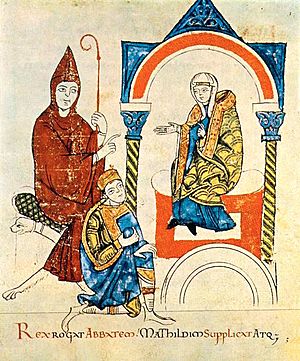Investiture Controversy facts for kids
The Investiture Controversy was a big fight between the Church and the rulers of Europe during the Middle Ages. It was all about who had the right to choose and appoint local church leaders, like bishops and abbots. This disagreement caused nearly 50 years of civil war in Germany. It also weakened the power of the Holy Roman Empire.
Many historians believe the Investiture Controversy was a major turning point in medieval history. It marked the end of the Early Middle Ages and showed that the Germanic peoples had fully accepted Christianity. More importantly, it helped shape the religious and political systems of the High Middle Ages.
The main conflict started in 1056 between Pope Gregory VII and Emperor Henry IV. There was also a shorter but important fight between Pope Paschal II and King Henry I of England from 1103 to 1107.
The big argument finally ended in 1122. Pope Callixtus II and Emperor Henry V signed an agreement called the Concordat of Worms. This agreement made it clear that there were different powers for kings and for the Church. It gave emperors a limited role in choosing bishops. The Church, especially the Pope, mostly won this struggle, but the Emperor still kept a lot of power.
Contents
What Was the Investiture Controversy?
In the 11th and 12th centuries, several popes challenged the power of European kings. They argued about who had the right to "invest" or appoint local church officials. These officials included bishops in cities and abbots who led monasteries.
Why Was This Fight Important?
Before this conflict, kings and emperors often chose bishops and abbots. These church leaders were very powerful. They controlled a lot of land and wealth. They also had a lot of influence over people. Kings wanted to choose loyal people for these jobs. This way, the church leaders would support the king's rule.
However, the Popes believed that only the Church should choose its own leaders. They felt that kings appointing bishops was wrong. It was like the government telling a sports team who their coach should be. The Popes wanted the Church to be independent from kings and emperors. They wanted the Church to have its own authority.
Key People in the Conflict
The main figures in the Investiture Controversy were Pope Gregory VII and Emperor Henry IV.
Pope Gregory VII's Role
Pope Gregory VII was a very strong and determined leader. He believed that the Pope had supreme authority over everyone, including kings. He wanted to reform the Church and stop kings from interfering in church matters. In 1075, he issued a decree saying that only the Pope could appoint or remove bishops.
Emperor Henry IV's Role
Emperor Henry IV was the ruler of the Holy Roman Empire. He believed that he had the traditional right to appoint bishops in his lands. These bishops were important to his power. They helped him govern and provided soldiers for his armies. When Pope Gregory challenged his authority, Henry IV was very angry.
The Conflict Heats Up
The disagreement between Pope Gregory VII and Emperor Henry IV quickly became very intense.
Henry IV's Walk to Canossa
In 1076, Pope Gregory VII took a very serious step. He excommunicated Emperor Henry IV. This meant Henry was kicked out of the Church. For people in the Middle Ages, this was a huge deal. It meant they believed Henry could not go to heaven. It also meant his subjects were no longer required to obey him.
Facing rebellion from his own nobles, Henry IV had to act. In January 1077, he traveled to Canossa in Italy. This was where the Pope was staying at a castle. Henry stood outside in the snow for three days, begging for the Pope's forgiveness. Finally, Gregory lifted the excommunication. This event showed the Pope's great power at the time.
The End of the Conflict: Concordat of Worms
Even after Canossa, the fight continued for many years. It involved several Popes and Emperors.
The Agreement in Worms
The Investiture Controversy finally ended in 1122 with the Concordat of Worms. This agreement was signed by Pope Callixtus II and Emperor Henry V (Henry IV's son).
The Concordat of Worms made a clear difference between the spiritual power of the Church and the worldly power of kings.
- The Church would choose and consecrate bishops and abbots. This meant the Church would give them their spiritual authority.
- The Emperor could be present at the elections of bishops. He could also give the chosen bishop symbols of their worldly power, like land and property.
This agreement was a compromise. The Church gained more independence in choosing its leaders. However, the Emperor still had some influence because he could give them their lands. Overall, it was seen as a victory for the Papacy. It strengthened the Pope's authority in Europe.
Images for kids
-
The Avignon Papacy happened centuries after the Concordat, showing kings still tried to influence the Pope.
See also
 In Spanish: Querella de las investiduras para niños
In Spanish: Querella de las investiduras para niños







